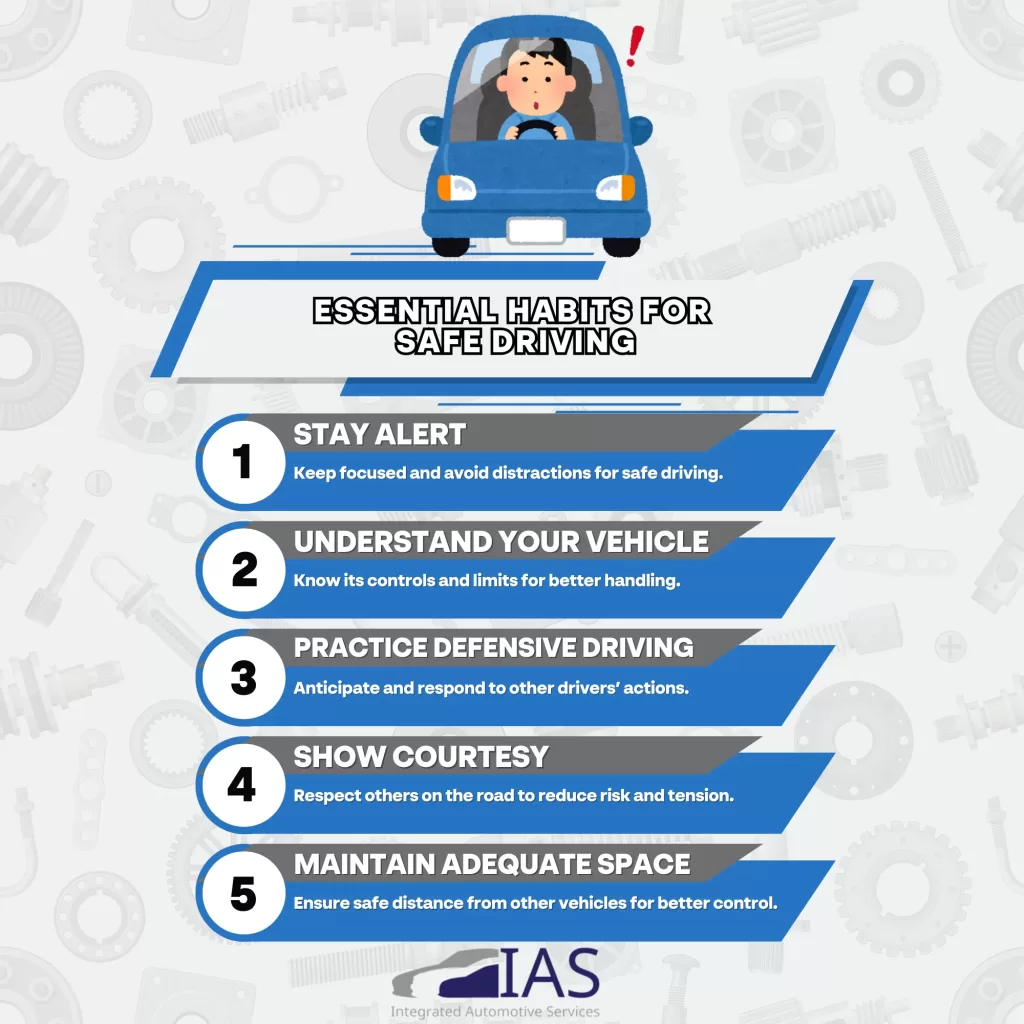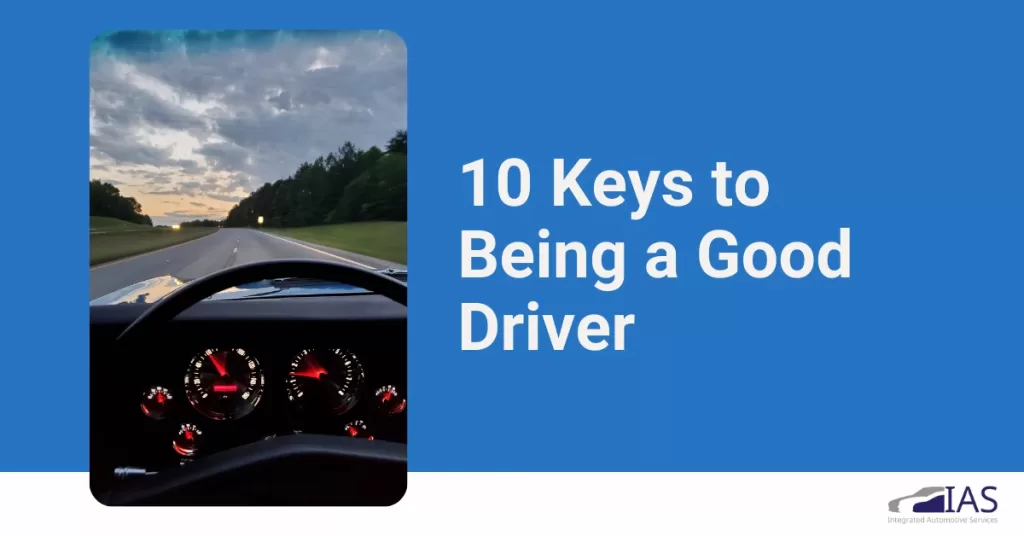Being a good driver involves much more than handling a steering wheel. Start by preparing thoroughly – adjust your seat and mirrors and plan your route in advance. Understand your vehicle’s dimensions and control systems, and keep it maintained. Stay in control, practice defensive driving, and make sure to keep your attention undivided on the road. Regularly check mirrors and anticipate the actions of other drivers. Courtesy also goes a long way – respect other road users. Finally, maintain adequate space between vehicles and cultivate confidence. That’s just the tip of the iceberg, there’s a wealth of knowledge to explore!

Key Takeaways
- Maintain vehicle regularly and understand its performance characteristics for better control.
- Stay alert and focused on the road, avoiding all distractions.
- Develop driving skills to handle diverse weather and road conditions confidently.
- Practice courtesy on the road, respecting other drivers, cyclists, and pedestrians.
- Ensure adequate space between vehicles and cultivate confidence for efficient decision-making on the road.
Being prepared
Preparation is the key to being a good driver. It’s not just about knowing how to operate your vehicle, but developing good driving habits that promote safety and efficiency.
Before you even start the engine, take a moment to adjust your seat, mirrors, and safety belt. Your seat should be positioned so that you can easily reach the pedals and steering wheel. Mirrors should be adjusted to provide a clear view of the road behind and to the sides of your vehicle. Your safety belt should fit snugly across your hips and shoulder, not your stomach or neck.
Next, plan your route before you head out. Knowing where you’re going reduces stress and diminishes the likelihood of dangerous last-minute maneuvers. If you’re using a GPS, program your destination before you start driving.
Always keep an eye on the weather. Adverse conditions like rain, fog, or snow require different driving tactics.
Don’t forget to keep your vehicle well-maintained. Regular checks of your tire pressure, oil level, and brakes can prevent breakdowns and accidents.
Knowing your vehicle
Understanding your vehicle is an essential aspect of good driving. As a good driver, you should know your vehicle’s capabilities and limitations. Familiarize yourself with its size and dimensions. You’ll navigate traffic and park more efficiently if you’re aware of how much space your vehicle needs.
It’s also important to understand your vehicle’s control systems. Know how to operate the wipers, lights, turn signals, and emergency flashers without taking your eyes off the road. You should also be comfortable with the air conditioning and heating systems, as well as the radio and other infotainment options.
Get acquainted with your vehicle’s performance characteristics too. How does it respond to acceleration and braking? How does it handle in different road conditions? Remember, every vehicle behaves differently, and what works for one mightn’t work for another.
Keep an eye on your vehicle’s maintenance needs as well. Regular oil changes, tire rotations and brake checks are vital for safe operation.
And don’t forget about your vehicle’s safety features. Understanding how these work could be a lifesaver in an emergency situation.
Knowing your vehicle thoroughly will make you a more confident, safer, and ultimately, a good driver.
Staying in-control
As a motorist, maintaining control over your vehicle is paramount. It’s not just about steering and braking, but also understanding your car’s capabilities and limitations. This knowledge forms an essential part of safe driving.
Being in control means predicting and reacting to road conditions effectively. Stay alert for changing weather, traffic congestion, and unexpected obstacles. You can’t control these factors, yet your response dictates how well you preserve control.
Proper vehicle maintenance is also a key aspect. A well-maintained car responds predictably, enabling you to remain in control. Regularly check your tires, brakes, and steering system. You’re not just ensuring the vehicle’s functionality but also fortifying your control over it.
Remember, your mental state affects your driving control as well. Stress, fatigue, and distractions can impair your ability to react promptly. So, always be calm and focused when you’re behind the wheel.
Lastly, practice defensive driving. Anticipate other drivers’ actions, maintain a safe distance, and obey speed limits. This proactive approach helps you stay in control and contributes to an overall safe driving environment.
Mastering control over your vehicle isn’t an overnight process. It requires consistent practice and conscious effort. But it’s worth it for the safety and peace of mind it brings.
Using your car correctly
Knowing how to maintain control of your vehicle is just one aspect of safe driving. Beyond this, using your car correctly has a significant impact on your driving safety. It’s more than just turning the key and hitting the gas. Understanding your car’s unique features and limitations is paramount.
To begin with, you should always adjust your mirrors and seats before setting off. This guarantees you’ve got ideal visibility and control.
In addition, familiarize yourself with your car’s signals and indicators. You’ll need to know when it’s signaling low fuel, engine trouble, or an unfastened seat belt.
Thirdly, understand your car’s limitations. Every car has its own braking distance, turning radius, and acceleration rate. Don’t push your car beyond its capabilities.
Staying alert
The road demands your undivided attention. Staying alert is crucial to driving safe. It’s more than just keeping your eyes on the road. It’s about being mentally present and ready to react swiftly to any unexpected situations.
You’re not just driving your car; you’re also maneuvering a rapidly changing environment filled with other vehicles, pedestrians, and potential hazards. It’s essential to be aware of what’s happening around you at all times. Regularly check your mirrors to keep track of the vehicles behind and beside you.
Monitor the road ahead for any changes in traffic patterns or road conditions. Avoid distractions that could divert your attention, like your phone or the car’s infotainment system. If you’re tired or feeling unwell, it’s better to pull over and rest than risk an accident.
Even a moment’s inattention can have serious consequences. Staying alert also means anticipating the actions of others. Don’t assume that everyone else on the road will behave predictably. Always be prepared for the unexpected and react calmly and decisively.
Having the skills… to avoid paying the bills
Behind the wheel, it’s your skills that can save you from shelling out on costly repairs and fines. As a good driver for beginners, you must understand that driving isn’t just about getting from point A to point B. It’s about doing it safely and efficiently.
You’ve got to master control of your vehicle. This means knowing how to handle your car in all sorts of weather and road conditions. It’s about being able to react quickly and effectively when something unexpected happens. Don’t just rely on your brakes – learn how to use your gears to control your speed, particularly on steep hills or slippery roads.
Visibility is crucial. Make certain you can always see clearly by keeping your windows clean and free of obstructions. Learn how to use your mirrors effectively and remember to check them frequently.
Remember, it’s not just about avoiding accidents, but also avoiding wear and tear on your car. Smooth, controlled driving helps to reduce the strain on your vehicle, extending its lifespan and saving you money in the long run.
In short, being a good driver is about more than just following the rules of the road. It’s about developing a set of skills that will help you navigate any situation.
Reading the road… and other drivers
One essential aspect of being a savvy driver is mastering the art of reading both the road and other drivers. This means understanding road signs, markings, and traffic rules, but also predicting the behavior of other drivers.
When you’re driving, always scan the road ahead for potential hazards. Look out for obstacles, road conditions that might affect your vehicle, and changes in traffic patterns. Pay attention to signs indicating speed limits, road works, or detours. They’re there to guide you safely on your journey.
Reading other drivers, on the other hand, is a bit trickier. You can’t see inside their vehicle or know what they’re thinking, but you can observe their driving behavior. Are they driving aggressively or erratically? Are they maintaining a safe distance from your vehicle? Are they signaling their intentions correctly?
Your job is to anticipate their actions and react accordingly. If you see a driver swerving or speeding, keep your distance. If a driver isn’t using their signals properly, be extra cautious.
Your safety on the road depends on your ability to read the road and other drivers effectively. Remember, good driving isn’t just about controlling your vehicle, but also maneuvering the unpredictable world of the road.
Being courteous
Driving with courtesy isn’t just about being polite, it’s a key aspect of safe, responsible driving. As a conscientious driver, you’re not just responsible for your own actions, but also for how you interact with others on the road.
Being courteous is about showing respect for other drivers, pedestrians, and cyclists. It’s about understanding that everyone has a right to travel without fear or frustration.
Being courteous involves a variety of behaviors. You should use your turn signals well in advance of making a maneuver, giving others ample time to react. You should also refrain from honking unnecessarily. A horn is meant for alerting others to danger, not expressing frustration.
Tailgating is another behavior to avoid, as it can intimidate other drivers and increase the risk of accidents.
When it comes to driver safety, being courteous plays a significant role. It can defuse potential road rage situations and reduce the likelihood of accidents.
Giving everyone room
While on the road, it’s essential that you guarantee there’s adequate space between your vehicle and others. This is a critical aspect of how to be a good driver. Giving everyone room is more than just a courtesy—it’s a safety measure.
In heavy traffic, try to maintain at least a two-second distance between your car and the one in front. It’s easy to calculate: when the vehicle ahead passes a fixed point, count “one thousand one, one thousand two.” You shouldn’t reach that point before you’ve finished counting.
If someone is tailgating you, don’t retaliate by braking suddenly or slowing down excessively. Instead, if possible, change lanes or gently increase your own following distance, encouraging them to overtake.
Remember, it’s not just about the space in front and behind. Check your side mirrors regularly to maintain safe distance from vehicles in adjacent lanes.
Consider cyclists and pedestrians too, especially in residential areas and school zones.
Being confident
Almost every experienced driver can attest to the importance of confidence in safe driving. Confidence behind the wheel allows you to make decisions quickly and efficiently, ensuring your safety and the safety of others on the road.
But remember, confidence shouldn’t morph into overconfidence, as that’s a recipe for reckless driving.
Being a good defensive driver, you need to cultivate this confidence. Here’s how:
- Know your vehicle: Understand its dimensions, capabilities, and limitations. This knowledge builds your confidence and makes you a better driver.
- Practice regularly: Like any skill, driving improves with practice. Regular driving in various conditions will boost your confidence.
- Stay calm: Stress and panic can lead to mistakes. Keep your cool, even in difficult driving situations.
Frequently Asked Questions
What Services Are Included in Routine Maintenance for My Vehicle?
Routine maintenance for your vehicle typically includes oil changes, brake checks, tire rotations, and inspections of belts, hoses, and fluids. It’s essential to keep these up to date for your car’s longevity.
How Often Should I Get My Car Inspected and Checked for Emissions?
You should get your car inspected annually. Emissions testing depends on your state’s laws, but typically it’s every 1-2 years. Regular check-ups guarantee your car’s running smoothly and meets environmental standards.
Whats the Significance of Getting My Timing Belt Professionally Replaced?
Getting your timing belt professionally replaced is like ensuring your heart’s rhythm is perfect. It’s essential for your car’s smooth operation, preventing engine failure and saving you from costly, unexpected repairs down the road.
What Is the Warranty on the Repair or Replacement Services Provided?
You’re covered with a robust warranty on services provided. It’s a 2-year/24,000-mile warranty, guaranteeing top-quality work. It’s their commitment to guarantee you’re completely satisfied with the repairs or replacements done on your vehicle.
Do You Provide Any Special Services for Specific Car Brands Like Audi or Toyota?
Yes, you’re in luck! We specialize in various car brands including Audi and Toyota. Our certified technicians offer thorough care for these high-performance vehicles, ensuring your ride stays smooth and efficient. Trust us for reliable service.
Conclusion
So, you’ve navigated the highway of knowledge, and now it’s time to put theory into practice. Remember, being a good driver isn’t just about the destination, it’s about the journey. Stay alert, be courteous, and always give room. Confidence is key, yet tempered with caution. With these tools in your driving arsenal, you’re ready to hit the open road. Remember – the world is your highway, and you’re in the driver’s seat. Drive safe, drive smart.



